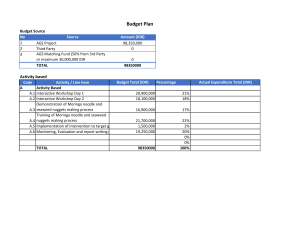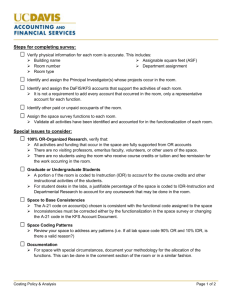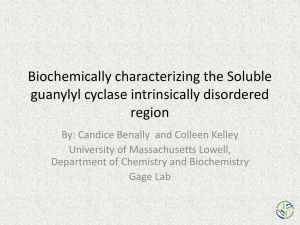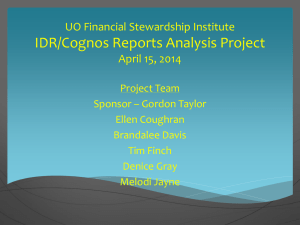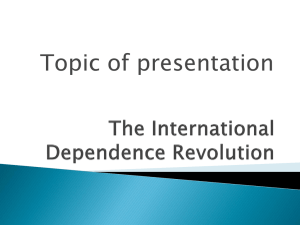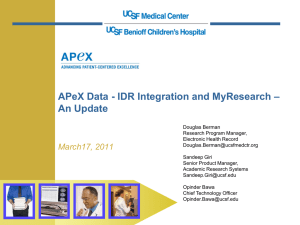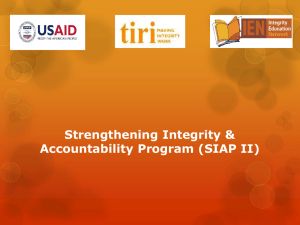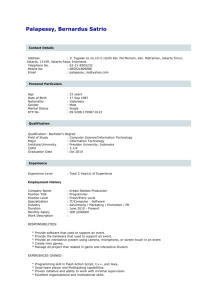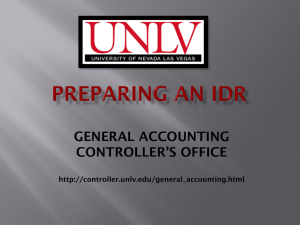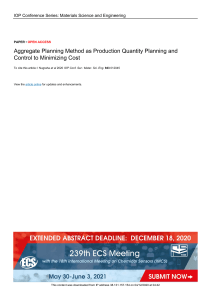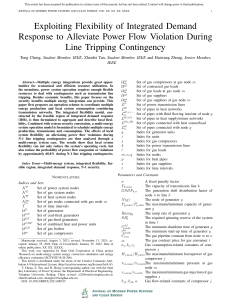here
advertisement
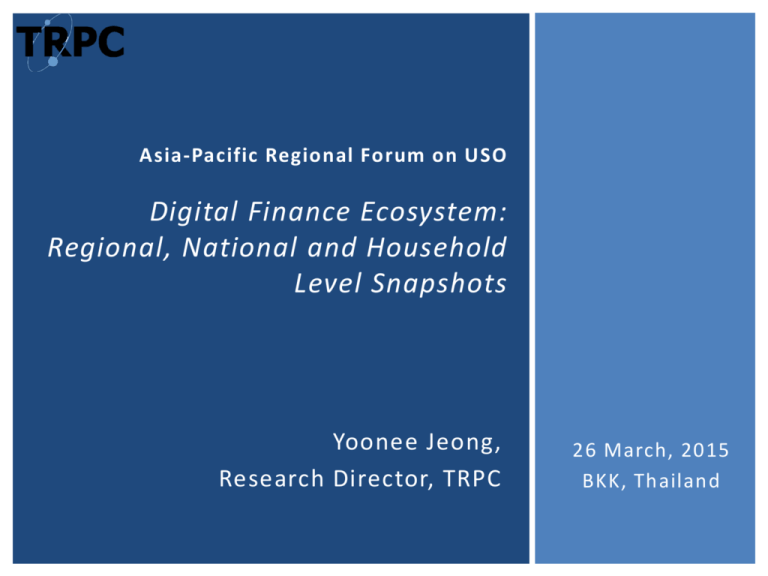
Asia-Pacific Regional Forum on USO Digital Finance Ecosystem: Regional, National and Household Level Snapshots Yoonee Jeong, Research Director, TRPC 26 March, 2015 BKK, Thailand * KEY TAKEAWAYS Understanding risk profile at different levels of the digital payment value chain Understanding the players involved, incentives and trade-offs Roles of international/regional players, government, and the private sector Why flexible and holistic framework approach 1. HH LEVEL: INCOME PROFILE Sources of Income # of Income Earners Full time employment 64% Selling of goods and services Part time employment Remittance (within Indonesia) Others 3% 48% 9% 21% 9% 42% 3% Agriculture/livestock 0.7% Rent collection/Interest 0.6% Remittance (from abroad) 0.3% Inheritance 0.1% 46% One Two Three Four 1. HH LEVEL: EXPENDITURE PROFILE Monthly Average Household Expenditure IDR 900,000 IDR 800,000 IDR 700,000 IDR 600,000 IDR 500,000 IDR 400,000 IDR 300,000 IDR 200,000 IDR 100,000 IDR - 1. HH LEVEL: FINANCIAL RESILIENCE Had to borrow to pay for monthly expenditure? Who did you borrow from? 4% 1% 6% 5% 9% 41% 43% 0% 58% 18% 14% Yes No Family Provident Fund Employer Bank Money Lenders Friends Local Co-Op Pawn broker Neighbors 1. HH LEVEL: PERCEPTIONS Credit cards: higher association with negative images of indebtedness (“wasteful”) Debit cards: generally positive images, but also associated with the wealthier income brackets (“wealthy ”) m-Money: associated with fast and modern transactions (i.e. not necessarily relevant to them) 45% 40% 35% Wealthy Risky Wasteful Convenient Modern Fast (transactions) 30% 25% 20% 15% 10% 5% 0% M-Money Debit Cards Credit Cards 1. HH LEVEL: BARRIERS TO ADOPTION Reasons for not having a bank account Do not have enough money for min balance 8% 41% Prefer to have physical savings 3% Do not know how to open or manage an account 24% 5% 15% 20% 12% 5% 4% 5%2% Do not want to pay additional charges (hidden or otherwise) 1% 7% 4%1% 1% Bank facilities too far, hence inconvenient 1%4%2% No experience with the bank 1% 1% Previously had an account but the bank closed it 1% Poor experience with banks 1% Do not trust banks or other financial institutions 1% Can’t open an account due to lack of required ID 0% 0% <IDR1M IDR1M-2M IDR 2M-3M 10% 20% IDR3M-5M 30% 40% IDR5M-7.5M 50% 60% 70% >IDR7.5M 80% 1. HH LEVEL: BARRIERS TO ADOPTION 64% 61% M-Payment/Wallet M-Banking 66% 50% 19% 13% 5% 21% 18% Don’t know Prefer to Too difficult Don’t see how to use use cash or or time any benefit services other consuming from using methods to use 9% 8% 7% 4% 6% 6% 4% 4% 4% 2% 2% 3% 1% Concerns Phone Don’t know Transaction Not offered Don’t trust Data fee is doesn’t any stores charges are by my bank the mobile too high about security support the that let you too high or mobile technology feature pay with operators with my mobile money phone 1. HH LEVEL - FINDINGS Cash is still King – a viable alternative has yet to emerge Spending needs are liquid, frequent and informal Use of mobiles is more central than ever – but no one has made a compelling proposition for m-money (e.g. ease of use - 61.9%, safety for money - 11.8%) Earners and Spenders within HH are often different – current m-money offering target both audiences simultaneously Network effects show some promises (e.g. 54% willing to give m-money a try if a family/friend uses it. Higher proportions of females, urban households and aged 21-30 willing to try. 2. NAT’L LEVEL - LANDSCAPE MAP (LK) 2. NAT’L LEVEL - LANDSCAPE MAP (LK) FSI TELCO/MNOs Central Bank 1 REGULATE Telco Regulatory Commission M-MONEY Financial Coms 2 PROVIDE 3 PARTICIPATE Banks Spec Leasing Coms M-Banking • - M-Wallet Payment MNOs M-Wallet/Payment Insurance Companies 3RD Party Platform Providers Retailers Utility Service Providers 2. NAT’L LEVEL: INSTITUTIONAL CHECKLIST (MN) Policy Goals? Additive or Transformational? Bank-centric or Telco-centric or Hybrid or Market-driven? Risks? Regulatory Response? Regulatory – and Administrative – Responsibility? (e.g. primary/2ndary) Temporary or Institutionalized? Legislation? What to legislate and what to leave to market forces? Whose rights are being protected and for what purpose? 2. NAT’L LEVEL: REGULATORY CHECKLIST (MN) Payment Systems Prudential Risk Management AML/ CFT/ KYC Agent Networks e-Money Telecommunications Regulation Competition Consumer Protection e-Commerce & e-Security Foreign Exchange Taxation 2.NAT’L LEVEL: RESPONSIBILIT Y MATRIX Payment Systems Prudl Risk Management AML/ KYC Agent eMoney Telecom Compete Networks & IT Regs Consumer Protection 1 2 3 1 2 3 1 2 3 1 2 MoF √ √ ~ ~ ~ ~ √ √ √ BoM √ √ √ √ √ √ √ √ √ √ √ ~ ~ √ ~ FRC √ √ √ √ √ √ √ √ √ √ √ √ √ √ √ NCP √ √ √ ~ ~ ~ ~ ~ ~ √ √ NDIC ~ √ ~ ~ √ ~ ~ ~ ~ MBA ~ √ ~ ~ √ ~ ~ √ ~ ~ √ ~ ~ √ ~ ~ √ ~ ~ 3 1 2 3 1 2 3 1 2 3 eCommerce Forex Taxes 1 2 3 1 2 3 1 2 3 1 2 3 ~ ~ ~ ~ √ ~ √ √ √ √ ~ √ √ √ √ √ √ ~ ~ ~ ~ √ √ √ √ √ √ √ √ √ ~ ~ ~ √ √ √ ~ √ √ √ ~ ~ ~ ~ √ ~ ~ ~ ~ ~ ~ ~ √ √ ~ √ √ ~ ~ ~ ~ ~ ~ ~ √ ~ ~ ~ ~ ~ √ ~ ~ √ ~ √ √ √ √ ICPTA √ ~ ~ ~ ~ √ √ √ ~ √ ~ √ √ √ ~ √ ~ √ √ ~ √ √ √ CRC √ ~ ~ ~ ~ ~ √ √ √ √ √ √ √ √ √ √ √ √ √ ~ √ √ ~ UCRA ~ √ ~ ~ √ ~ √ √ ~ √ √ √ √ √ √ √ √ √ ~ ~ ~ Tax √ √ ~ ~ ~ √ ~ √ √ ~ √ √ √ √ √ √ ~ √ √ ~ 1 = Key regulatory or policy role to play currently √ = active role 2 = Information role or requirement ~ = role not clear 3 = Anticipated future regulatory role Primary responsibility highlighted by boxed squares Green = existing laws Yellow = some laws Red = No existing law 3. BEYOND-THE-BORDER ISSUES Data localisation requirement Local content requirements Labelling requirement Limitations in franchise and dealership Negative Investment List, limitation in foreign ownership, limitations to divestment Can lead to over-reach, over-regulation, and counter-productive impact from an economic and trade perspective. COST OF COMPLIANCE Telcom Privacy Commission Implementation & Enforcement Compliance Banking Privacy Law COST OF COMPLIANCE IMF projections W across-the board localisation CN 7.7% 6.6% IN 4.4% 3.6% ID 5.8% 5.1% KR 2.8% 1.7% VN 5.4% 3.5% Source: ECIPE, 2014, The Costs of Data Localisation: Friendly Fire on Economic Recovery WEIGHING THE COST VS OPPORTUNITIES Protect ‘national interests’ • balance of payment and tax base • local industry growth and ecosystem • personal data privacy Promote opportunities for low-income families and local companies to engage in mainstream and global value chain • e/m-commerce, • e/m-payment, • outsourcing • regional economic integration * FRAMEWORK APPROACH Understanding the transformational benefits of mobile money, forumulate and state clear objectives POLICY CLARITY Establishing a holistic view encompassing all players Clarifying gaps and overlaps in existing regulatory framework(s) Institutional + Activity-based approach Horizontal + Vertical perspectives Coordination across agencies in developing a regulatory roadmap Prioritising specific elements within policy and regulatory roadmap – rather than trying to get everything right from the outset Adjust flexibility and rigor according to risks
